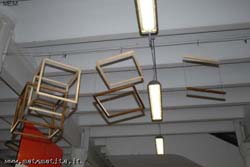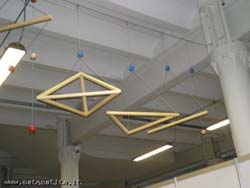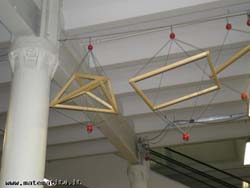As we can imagine a hypercube or other objects in four-dimensional space, could we think of 5, 6, or more, dimensions? The answer is positive and it is not even more difficult conceptually: at the most it is our imagination to be challenged. For instance, we can think of the n-dimensional space as the set of n-tuples of real numbers. As for the plane, we can introduce a coordinate system and identify a point on the plane with a pair of real numbers; in three-dimensional space any point is identified with a triple of numbers. Therefore, an n-dimensional space has the right to exist for any n. Of course, this does not help much to imagine objects in this space.
Let us go back to a hypercube. We obtain a hypercube from a cube with the same abstract procedure as the one we use in order to obtain a cube from a square. This will be called the prism construction. According to it, we can start from a point (dim. 0) and imagine to obtain a segment (dim. 1); next a square (dim. 2), next a cube (dim. 3) and finally a hypercube (dim. 4).
There is no reason why we should stop: the prism over a hypercube of dimension four will be a hypercube of dimension 5 and so on.
Also using coordinates, we can center our objects in the origin and arrange them so that the edges are parallel to the coordinate axes. Then a square (with edge two) has four vertices (±1,±1); The vertices of a cube are the eight points (±1,±1,±1); The vertices of a hypercube are the 16 vertices (±1,±1,±1,±1). So forth, we will obtain that the vertices of a hypercube in n-dimensional space are the 2n points (±1,±1,...,±1,±1).
There are other constructions which can be repeated infinitely many times, for instance, the pyramid construction. It can be applied to obtain a tetrahedron from a triangle. It suffices to join a point not on the plane where the triangle lies with all the vertices of the triangle. If you start with an equilateral triangle you will get a regular tetrahedron if the following conditions are satisfied: i) the point is on the line perpendicular to the plane where the triangle lies and passing through the barycenter, and ii) the height is taken in such a way that all faces are equilateral triangles.
Coordinatewise, the easiest way to visualize this construction is to start from a triangle on the plane x+y+z=1 in three-dimensional space. The vertices are the points (1,0,0), (0,1,0), (0,0,1).
In (n+1)-dimensional space, the n+1 points (1,0,...,0),...,(0,...0,1) are vertices of a hypertetrahedron in dimension n.
Another construction, that we will call the bipyramid, allows one to get a regular octahedron from a square and, at the next step, a hyperoctahedron in four dimensional space from an octahedron.
Coordinatewise, the four points (±1,0) e (0,±1) are vertices of a square. The six points (±1,0,0), (0,±1,0), (0,0,±1) are vertices of a regular octahedron. In general, the 2n points (±1,0,...,0),..., (0,...,0,±1) are vertices of a hyperoctahedron in n-dimensional space.
It is interesting to note that in dimension greater than or equal to 5 one can prove that these are the only regular polytopes. The 120-cell, the 600-cell and the 24-cell are specific “accidents” of dimension four. Analogously the icosahedron and the dodecahedron are specific “accidents” of three-dimensional space.


